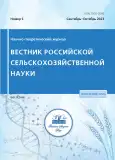Productivity of crop rotations depending on the degree of saturation of alfalfa and winter wheat with stubble natural phytocenosis in the Western Caspian region
- Authors: Guseynov A.A1, Arslanov M.A1, Gasanov G.N1, Bashirov R.R2, Mirzaeva K.M1
-
Affiliations:
- Dagestan State Agrarian University named after M.M. Dzhambulatov
- FGBUN Dagestan State Federal Research Center RAS (DFRC RAS)
- Issue: No 5 (2023)
- Pages: 33-36
- Section: Articles
- URL: https://journals.rcsi.science/2500-2082/article/view/233562
- DOI: https://doi.org/10.31857/2500-2082/2023/5/33-36
- EDN: https://elibrary.ru/XGGDTU
- ID: 233562
Cite item
Full Text
Abstract
About the authors
A. A Guseynov
Dagestan State Agrarian University named after M.M. Dzhambulatov
Email: arsmurat@yandex.ru
M. A Arslanov
Dagestan State Agrarian University named after M.M. Dzhambulatov
G. N Gasanov
Dagestan State Agrarian University named after M.M. Dzhambulatov
R. R Bashirov
FGBUN Dagestan State Federal Research Center RAS (DFRC RAS)
Kh. M Mirzaeva
Dagestan State Agrarian University named after M.M. Dzhambulatov
References
- Абдуллаев Ж.Н., Гасанов Г.Н., Бексултанов А.А. Приемы обработки каштановой почвы и продуктивность звена севооборота "пожнивная культура - озимая пшеница" в Приморской подпровинции Дагестана // Аграрная наука. 2012. №3. С. 9-12.
- Васильев И.П., Туликов А.М., Баздырев Г.И. и др. Практикум по земледелию. М.: Колос, 2005. 424 с.
- Власова О.И. Плодородие черноземных почв и приемы его воспроизводства в условиях Центрального Предкавказья: монография. Ставрополь: АГРУС, 2014. 308 с.
- Гайдученко А.Н., Синеговская В.Т., Толмачев М.В. Возделывание полевых культур в короткоротационных универсальных севооборотах в Амурской области // Земледелие. 2015. №5. С.3-5.
- Гасанов Г.Н., Арсланов М.А. О системах содержания почв в ирригационных агроландшафтах и их классификации // Земледелие. 2017. № 1. С. 21-24.
- Доспехов Б.А. Методика полевого опыта. М.: Колос, 1985. 416 с.
- Методические указания по проведению полевых опытов с кормовыми культурами. М.: ВНИИК, 1987. 198 с.
- Пенчуков В.М., Передериева В.М., Власова О.И. Биологизированные севообороты - эффективный путь сохранения плодородия почвы и повышения урожайности сельскохозяйственных культур // Вестник АПК Ставрополья. 2012. № 4. С. 114-117.
- Тамазаев И.Т. Видовой состав и продуктивность естественного фитоценоза и кукурузы на силос пожнивного посева в Терско-Сулакской низменности Прикаспия // Проблемы развития АПК региона. 2018. № 3 (35). С. 75-79.
- Федин М.А. Методика государственной комиссии по сортоиспытанию сельскохозяйственных культур. М.: Колос, 1985. 239 с.
- Черкасов Г.Н., Акименко А.С. Основы модернизации севооборотов и формирования их систем в соответствии со специализацией хозяйств Центрального Черноземья // Земледелие. 2017. № 4. С. 3-5.
- Черкасов Г.Н., Акименко А.С. Совершенствование севооборотов и структуры посевных площадей для хозяйств различной специализации Центрального Черноземья // Земледелие. 2016. №5. С. 8-11.
- Шрамко Н.В., Вихорева Г.В. Роль биологизированных севооборотов в изменении содержания гумуса в дерново-подзолистых почвах Верхневолжья // Земледелие. 2016. № 1. С.14-16.
Supplementary files










